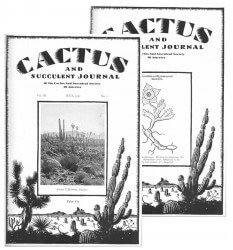Man nehme Granit, Sand und verschiedene andere leckere Zutaten, die man in keinem Fall sieben soll … und schon hat man eine Universal-Kakteenerde die mit einer kleinen Modifikation sogar für Epis anpassbar ist.
Fundstück in >The Cactus Journal, May, 1899<
CACTUS SOIL
There is one golden rule with reference to the soil most suitable for growing any wild plants, viz., imitate nature as nearly as possible. This we find rather difficult to do in the case of the Cactus family, as they are found wild, growing in so many different kinds of material (soil is hardly the correct word to use). Probably the greatest quantity are found in broken-up and disintegrated granite. In some places it takes the form of a coarse sand, in others broken rubble, all sizes, from that of a pea to a cocoanut. Some kinds are found in similarly broken- up limestone, others at the edge of brooks (usually quite dry), in a quite clay-like soil ; but in every case the drainage is perfect, especially when the plant grows upon the slope of hills or mountains. This is generally the case; there are always ten times as many found upon the south side as upon the north side, showing their preference for sun, even in a land where sunshine is the rule and not the exception, as is often the case here.
Granite is composed of many kinds of mineral substances, and when it becomes weathered and broken up it becomes mixed with a quantity of decayed vegetable matter. The roots of the plants cling to the large pieces of stone, and search about in the finer material for nourishing material to build up their succulent stem.
Granite is an igneous rock, and the intense baking sunshine in the native habitat of most Cacti, seems to almost burn the earth up into powder — at least, it dries all the moisture out of the surface — therefore we recommend the following mixture, which may be made up in large or small quantities :
- One part red sand
- one part silver sand
- one part pulverized bricks, or dust from brick-yard
- one part old mortar
- one part granite, or marble chippings from the stone-yard
- one part very old rotten leaf mould
- half part finely broken charcoal
- one part of burnt earth1
- three parts loam.
Well mix but do not sieve out the small pieces of rock, or lumps — in fact, don’t use a riddle at all. It will be seen that a good proportion of the above has been through the fire, and the whole will make a very porous mixture, yet the larger pieces will absorb and hold some moisture for a considerable time.
For Phyllocacti and Epiphyllums we recommend the above, with
- one extra part of leaf soil, and
- one part of very old well-rotted manure.
Many people cover the surface of the soil between the plant and the edge of the pot, with small pieces of white marble chippings. This certainly looks neat and clean; it also prevents surface evaporation, and also saves the plants from being splashed with the soil when watered with a rose or syringe. Be careful and don’t use gypsum, or what ie often called „white spar,“ in rockeries, which is a sulphate of lime, not a carbonate as marble. We recommend Cactus growers to mix up a good quantity of soil at one time. It will keep indefinitely and save a lot of trouble. The above mixture will do for all kinds of Cactus, and many other kinds of succulent plants, especially those found in arid desert and mountain lands.
- da habe ich keine Ahnung, was das sein könnte – gebrannte Erde?? [↩]
Über den Autor
im Podcast seit 2019
Blogger seit 2005,
Kaktusgärtner aus Passion - seit 1970,
... in einer Familie von Kaktusgärtnern seit 1822
... und Gärtner in der Blumenstadt Erfurt seit 1685







Na wunderbar – herzlichen Dank, wieder was gelernt.
Burnt Earth ist Terracotta. Der Begriff ist aber heute auch in den USA nicht mehr gebräuchlich.